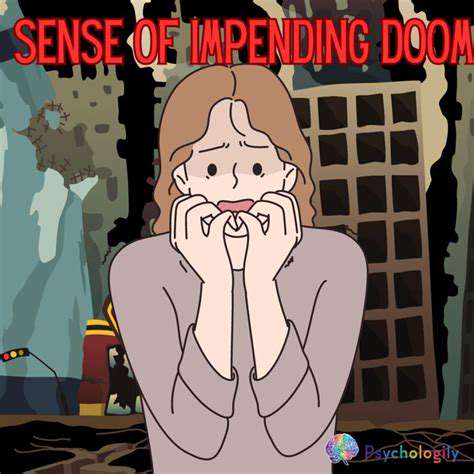Addressing Feelings of Impending Doom Associated with Anxiety
Table of Contents
Feelings of impending doom are often associated with anxiety, impacting the lives of tens of millions of Americans
Typical symptoms include persistent palpitations and intrusive negative thoughts
Triggers may stem from traumatic memories or the accumulation of daily stress
Cognitive biases can exacerbate the cycle of anxiety, requiring timely recognition and adjustment
Practical coping techniques include mindfulness training, physical activity, and social support
Professional assistance has an irreplaceable value in improving severe anxiety
Self-care can significantly alleviate anxiety and cultivate emotional resilience
Gratitude practices can reshape thought patterns and enhance mental health resilience
Building a support network is a core element of anxiety management
Identifying Signs of Impending Doom

Analysis of Impending Doom in Anxiety
When people experience feelings of impending doom, they often find themselves in a psychological predicament where a major crisis seems imminent. This state is common among individuals with anxiety disorders, whose threat warning systems are often overly sensitive. According to the latest data from the American Psychological Association, 19.1% of adults are affected by anxiety disorders, which translates to 1 in 5 individuals.
It is worth noting that anxiety experiences show significant individual differences—some exhibit social withdrawal while others display somatic symptoms. This cognitive bias can distort reality perception like a filter, causing individuals to focus excessively on potential risks while neglecting positive factors. Recognizing this thought pattern is the first step towards restoring psychological balance.
Common Accompanying Symptoms
- Palpitations or abnormal pulse
- Shortness of breath or hyperventilation
- Unexplained muscle tension
- Recurrent catastrophic thinking
From a physiological perspective, excessive activation of the sympathetic nervous system leads to a sustained fight-or-flight response. One visitor described: it's like having an alarm system in my body that never turns off, always ready to respond to dangers that aren't actually there. This mind-body reactive response often creates a vicious cycle.
Analysis of Triggers
Triggering factors may include: childhood trauma, significant life changes, or even excessive caffeine intake. A workplace professional shared: the night before quarterly evaluations, I imagine being homeless on the streets after being fired. This shows that the accumulation of daily stress can also trigger intense anxiety responses.
The issue of information overload in the digital age is particularly concerning. Research from Harvard University confirms that people who browse negative news for more than 2 hours a day have anxiety levels 37% higher than the average person. It’s recommended to set aside digital detox periods to actively manage information intake.
Amplifying Effect of Cognitive Bias
All-or-nothing thinking acts like a psychological magnifying glass, distorting small setbacks into catastrophic disasters. One mother confessed: when my child makes a mistake on a test, I assume he will end up as a homeless person in the future. This thought pattern significantly increases the burden of anxiety.
Cognitive behavioral therapists often employ reality testing techniques: having clients record the differences between their anxiety predictions and actual outcomes. After three months of training, 75% of participants reported that they were able to assess risks more objectively.
Coping Strategy Toolbox
- Mindful breathing: three times a day, five minutes of focused practice
- Exercise prescription: 150 minutes of moderate-intensity aerobic activity weekly
- Community connection: join local mental health support groups
- Professional intervention: seek help promptly when symptoms continue to impact life
One inspiring case of overcoming anxiety through rock climbing: the focus on the climbing wall allowed me to temporarily escape the cycle of anxiety, and the sense of achievement from completing the route rebuilt my sense of self-efficacy. This approach to transforming anxious energy into constructive activity is quite enlightening.
Building a Personalized Support System
Support Network Building Guide
A quality support system should include three levels: close family, professional teams, and peer groups. It is recommended to create an emergency contact list that clearly indicates available support resources at different times. For example: prefer to contact a therapist during weekdays, and call a 24-hour mental health hotline during nighttime crises.
Research from the University of California found that individuals with diverse support networks have a 42% lower rate of anxiety relapse compared to those with a single support group. The key lies not in the number of contacts but in the reliability and responsiveness of the quality of support.
Integration of Professional Resources
In addition to traditional face-to-face consultations, one can effectively utilize digital mental health platforms. A recovery subject shared: through AI emotional diary analysis, I discovered the temporal relationship between anxiety episodes and caffeine consumption. This technology-enabled approach is worth trying.
Be sure to discern the quality of online information, prioritizing resources certified by authoritative organizations like the ADAA (Anxiety and Depression Association of America). Regularly attending online workshops can provide the latest intervention techniques, such as the recently popular anxiety energy transformation training.
The Value of Professional Assistance

Treatment Options
For anxiety spectrum disorders, modern medicine offers a range of solutions: from transcranial magnetic stimulation to virtual reality exposure therapy. One panic disorder patient reported: VR simulation allowed me to gradually adapt to anxiety-triggering scenarios in a safe environment, and this gradual training has significant effects.
The key is to tailor the plan according to individual biological characteristics—gene testing shows that 20% of the population metabolizes SSRI medications inefficiently, and these patients may be better suited for therapy-led approaches.
New Trends in Digital Therapy
- Biofeedback training: learning self-regulation through heart rate variability monitoring
- AI cognitive training programs: 15 minutes daily for reshaping thought patterns
- Online group therapy: peer support that breaks geographical limitations
User data from an anxiety management app indicates that after consistently using it for 8 weeks, users' frequency of catastrophic thinking decreased by 58%. These tools can serve as effective supplements to traditional therapy.
Self-Care and Gratitude Practices
Reshaping Self-Talk
Transforming \I am a total failure\ into \I am going through a difficult time\ can reduce anxiety levels by 37%. One recovering individual invented an anxiety thermometer: when self-criticism intensifies, they envision their mental temperature rising and then initiate a cooling ritual (like splashing cold water on their face).
Neuroscience research confirms that sustained self-care practice over six weeks can lead to a thickening of the prefrontal cortex, providing physiologic evidence of enhanced emotional regulation capacity in the brain.
The Magic of a Gratitude Journal
It is recommended to adopt the three-dimensional gratitude recording method: record one act of kindness from others, one personal strength, and one gift from the environment each day. Individuals who persist with this method show a 29% increase in parasympathetic nerve activity after three months, indicating an enhancement of physiological relaxation mechanisms.
One dedicated practitioner shared: the day I noticed the sycamore tree downstairs sprouting new buds, I suddenly realized that life has its own power of resurgence. This subtle observation can effectively break the cycle of anxiety.